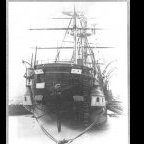Supplies of the Ship Modeler's Handbook are running out. Get your copy NOW before they are gone! Click on photo to order.
×
-
Posts
3,084 -
Joined
-
Last visited
Reputation Activity
-
 Jaager reacted to Roger Pellett in Minwax Helmsman or other spar varnish for waterproofing
Jaager reacted to Roger Pellett in Minwax Helmsman or other spar varnish for waterproofing
I know virtually nothing about RC models but I do have experience working with Epoxy. Epoxy can be tricky to use. It must be mixed in accordance with the specific resin/hardness ratios specified by the manufacturer. Different manufacturers use vastly different mixing ratios. If you add hardener beyond the specified ratio to “speed things up,” the mix will not cure, and you’ll wind up with a sticky mess. Since chemical formulations between brands vary, under no circumstances would I suggest trying to thin the resin. Use it as it comes from the can!
Epoxy cures with an Exothermic reaction- it gives off heat. A large batch can get quite hot. A thinner can effect this too in an unpredictable way.
Like most other things, you get what you pay for. The marine brands; West, System Three, etc IMHO are worth spending money on compared to the hardware store bands. West System requires a 5:1 resin to hardener ratio that can be hard to measure correctly. West System sells calibrated pumps that are foolproof or you can weigh out the materials with a scale. Other brands, such as I believe System Three feature an easier 1:1 ratio.
Epoxies now are available in a bewildering array, all with different specialized features. You can surely find a low viscosity one. OR. At least one high quality brand- West System is “modular.” The basic Resin/hardener mix results in a thin mix; about like maple syrup. West then sells different additives that allow the mix to be thickened to the consistency of peanut butter.
It’s your model to finish as you see fit, but working with Epoxy you have one and only one chance to get things right. Once you have coated your model, the outcome is in the hands of the Epoxy Gods. If the mix does not cure, you will wind up with a difficult if not impossible to remove sticky mess.
Roger
-
 Jaager got a reaction from robert952 in Planking improvement
Jaager got a reaction from robert952 in Planking improvement
Maybe try to leave the top edge of the garboard strake straight?
The bottom edge straight where the keel rabbet is parallel with the baseline?
Only trim the bottom edge where the stem rabbet is rising and to fit the sternpost rabbet?
Save the width adjustment for the rest of the planks between the garboard and the wale?
I have seen a few ships where the garboard was twice the thickness of the rest of the bottom planking.
There may have been enough differential movement stress between what the keel wanted to do and the garboard wanted to do that making the garboard less than robust was a bad idea.
-
 Jaager got a reaction from robert952 in Planking improvement
Jaager got a reaction from robert952 in Planking improvement
I think that Mother Nature limits the width possible - except for CA Redwood size timber, so I have not made much note of the width - believing 10"-12" to be the outside limit. No reference to footnote.
It was the thickness. It was from the 1840-1860 large commercial carrier - speed = money period that my memory wants to assign this. I was thinking when I saw it - they really could have used a laminar flow test tank to see the effect of sharp irregular edges of the step down planking.
-
 Jaager got a reaction from Canute in Adding to my resource library
Jaager got a reaction from Canute in Adding to my resource library
https://americanhistory.si.edu/about/departments/work-and-industry/ship-plans
The two catalogs will list some of what is available.
The transition period from 1860 to WWI is not really a popular period and not a lot of books cover it.
My library:
OCEANOGRAPHIC SHIPS FORE AND AFT
NELSON,STEWART B
U S GPO
WASHINGTON
1971
BALTIMORE CLIPPER, THE 1930
CHAPELLE,H I
EDWARD W SWEETMAN
NEW YORK
1968
COAST GUARD UNDER SAIL ,THE
KING,IRVING H
US NAVAL INSTITUTE PRESS
ANNAPOLIS, MD
1989
OLD STEAM NAVY ,THE VOL.1
CANNEY,DONALD L
US NAVAL INSTITUTE PRESS
ANNAPOLIS, MD
1990
OLD STEAM NAVY ,THE VOL.2
CANNEY,DONALD L
CONWAY MARITIME PRESS
LONDON
1993
HISTORY OF THE SHIP - STEAM, STEEL AND SHELLFIRE
GARDINER,ROBERT ED
CONWAY MARITIME PRESS
LONDON
1992
The Mariners' Museum used to have plans for sale on their website, but there seems to have been a redesign.
They have/had many models from the transition period - most are strange ducks - I think they have materials from Newport News Shipbuilding and they are from 1891 on.
Try Mystic - who knows?
-
 Jaager got a reaction from Canute in Adding to my resource library
Jaager got a reaction from Canute in Adding to my resource library
You probably ought to understand that I am more from a minority party segment in all of this; in no way set any rules, and have an academic ( with lose rules ) bent. I am not always good at phrasing suggestions as suggestions. I meant it as a "you might not want to walk in that mine field, but go ahead if you wish" sort of comment. If you are exploring the possibilities you might wish for suggestions for survey books for each of the many eras and technologies. Our build log forum has a breakdown into several broad areas. Spending time there may offer a sample of what is available from kits and in the scratch half, what is available using monographs. Builds that start with just a sheet of plans are not as common as the shear number of possibilities possible from doing that.
Specializing is not at all a requirement. Covering an area that goes from rafts and hollowed out logs in prehistory to nuclear powered vessels tends to be a bit overwhelming for one lifetime. Becoming focused on at least a general segment of that range is one way to cope.
You found two books that are significant and fundamental to me. They are mostly about the end portion of the Age of Sail and are America centric. Getting a volume with foldout plans is an excellent find. My Bonanza reprints do not have that feature.
A problem with scaling up photo copies is that the line thickness also increases and things can get imprecise.
It would probably be more efficient for me if I could follow my own advise and stay focused. I am prone to distraction which makes finishing a project a rare thing. But, I have managed to keep a wall at 1860.
-
 Jaager got a reaction from Canute in Adding to my resource library
Jaager got a reaction from Canute in Adding to my resource library
"The History of the American Sailing Navy" H.I.C.
As tempting as it is to use the plans directly from the books, better results can be had by using copies of the originals. They are available from The S.I. ships' plans department. The cost is reasonable. Use the books as a catalog.
There are too many degrees of freedom with a bait that is that general. Isolate a specialty segment and ask about that. The more tightly focused is the subject area, the more useful will be any replies.
A popularity contest will give direction if your object is to build a huge library. That ambition is better achieved if you are your sole financial manager.
-
 Jaager got a reaction from Keith Black in Greetings from North Carolina
Jaager got a reaction from Keith Black in Greetings from North Carolina
Hello Tarheel,
I grew up in the city that is the third "R" of your three r's.😉
Where you be? The I 40 corridor?
I remember the Beaufort museum from when it was one floor of an old house, few if any ship models, and a flat sandbox under a table containing a very large stuffed Eastern Diamondback placed so as to scare to 'ell out you when walked around its corner.
Reading your intention, you reaaaaly ought to read this post at the top of this forum:
https://modelshipworld.com/topic/13703-for-beginners-a-cautionary-tale/
If plastic kits are your prior experience, be prepared to have your expectations disappointed by the instructions that come with most wooden kits. With plastic, the molds have already formed the WHAT your are assembling. The plans show HOW they go together. With wood, the plans show WHAT to fabricate. Except for purpose designed beginners kits, you are already supposed to know HOW to fabricate what is shown.
-
 Jaager got a reaction from Dave_E in Greetings from North Carolina
Jaager got a reaction from Dave_E in Greetings from North Carolina
Hello Tarheel,
I grew up in the city that is the third "R" of your three r's.😉
Where you be? The I 40 corridor?
I remember the Beaufort museum from when it was one floor of an old house, few if any ship models, and a flat sandbox under a table containing a very large stuffed Eastern Diamondback placed so as to scare to 'ell out you when walked around its corner.
Reading your intention, you reaaaaly ought to read this post at the top of this forum:
https://modelshipworld.com/topic/13703-for-beginners-a-cautionary-tale/
If plastic kits are your prior experience, be prepared to have your expectations disappointed by the instructions that come with most wooden kits. With plastic, the molds have already formed the WHAT your are assembling. The plans show HOW they go together. With wood, the plans show WHAT to fabricate. Except for purpose designed beginners kits, you are already supposed to know HOW to fabricate what is shown.
-
 Jaager got a reaction from mtaylor in Planking improvement
Jaager got a reaction from mtaylor in Planking improvement
I think that Mother Nature limits the width possible - except for CA Redwood size timber, so I have not made much note of the width - believing 10"-12" to be the outside limit. No reference to footnote.
It was the thickness. It was from the 1840-1860 large commercial carrier - speed = money period that my memory wants to assign this. I was thinking when I saw it - they really could have used a laminar flow test tank to see the effect of sharp irregular edges of the step down planking.
-
 Jaager got a reaction from mtaylor in Greetings from North Carolina
Jaager got a reaction from mtaylor in Greetings from North Carolina
Hello Tarheel,
I grew up in the city that is the third "R" of your three r's.😉
Where you be? The I 40 corridor?
I remember the Beaufort museum from when it was one floor of an old house, few if any ship models, and a flat sandbox under a table containing a very large stuffed Eastern Diamondback placed so as to scare to 'ell out you when walked around its corner.
Reading your intention, you reaaaaly ought to read this post at the top of this forum:
https://modelshipworld.com/topic/13703-for-beginners-a-cautionary-tale/
If plastic kits are your prior experience, be prepared to have your expectations disappointed by the instructions that come with most wooden kits. With plastic, the molds have already formed the WHAT your are assembling. The plans show HOW they go together. With wood, the plans show WHAT to fabricate. Except for purpose designed beginners kits, you are already supposed to know HOW to fabricate what is shown.
-
 Jaager got a reaction from PostCaptainAubrey in Greetings from North Carolina
Jaager got a reaction from PostCaptainAubrey in Greetings from North Carolina
Hello Tarheel,
I grew up in the city that is the third "R" of your three r's.😉
Where you be? The I 40 corridor?
I remember the Beaufort museum from when it was one floor of an old house, few if any ship models, and a flat sandbox under a table containing a very large stuffed Eastern Diamondback placed so as to scare to 'ell out you when walked around its corner.
Reading your intention, you reaaaaly ought to read this post at the top of this forum:
https://modelshipworld.com/topic/13703-for-beginners-a-cautionary-tale/
If plastic kits are your prior experience, be prepared to have your expectations disappointed by the instructions that come with most wooden kits. With plastic, the molds have already formed the WHAT your are assembling. The plans show HOW they go together. With wood, the plans show WHAT to fabricate. Except for purpose designed beginners kits, you are already supposed to know HOW to fabricate what is shown.
-
 Jaager got a reaction from Chuck Seiler in Planking improvement
Jaager got a reaction from Chuck Seiler in Planking improvement
I think that Mother Nature limits the width possible - except for CA Redwood size timber, so I have not made much note of the width - believing 10"-12" to be the outside limit. No reference to footnote.
It was the thickness. It was from the 1840-1860 large commercial carrier - speed = money period that my memory wants to assign this. I was thinking when I saw it - they really could have used a laminar flow test tank to see the effect of sharp irregular edges of the step down planking.
-
 Jaager got a reaction from Chuck Seiler in Planking improvement
Jaager got a reaction from Chuck Seiler in Planking improvement
Maybe try to leave the top edge of the garboard strake straight?
The bottom edge straight where the keel rabbet is parallel with the baseline?
Only trim the bottom edge where the stem rabbet is rising and to fit the sternpost rabbet?
Save the width adjustment for the rest of the planks between the garboard and the wale?
I have seen a few ships where the garboard was twice the thickness of the rest of the bottom planking.
There may have been enough differential movement stress between what the keel wanted to do and the garboard wanted to do that making the garboard less than robust was a bad idea.
-
 Jaager got a reaction from mtaylor in Planking improvement
Jaager got a reaction from mtaylor in Planking improvement
Maybe try to leave the top edge of the garboard strake straight?
The bottom edge straight where the keel rabbet is parallel with the baseline?
Only trim the bottom edge where the stem rabbet is rising and to fit the sternpost rabbet?
Save the width adjustment for the rest of the planks between the garboard and the wale?
I have seen a few ships where the garboard was twice the thickness of the rest of the bottom planking.
There may have been enough differential movement stress between what the keel wanted to do and the garboard wanted to do that making the garboard less than robust was a bad idea.
-
 Jaager got a reaction from mtaylor in Adding to my resource library
Jaager got a reaction from mtaylor in Adding to my resource library
https://americanhistory.si.edu/about/departments/work-and-industry/ship-plans
The two catalogs will list some of what is available.
The transition period from 1860 to WWI is not really a popular period and not a lot of books cover it.
My library:
OCEANOGRAPHIC SHIPS FORE AND AFT
NELSON,STEWART B
U S GPO
WASHINGTON
1971
BALTIMORE CLIPPER, THE 1930
CHAPELLE,H I
EDWARD W SWEETMAN
NEW YORK
1968
COAST GUARD UNDER SAIL ,THE
KING,IRVING H
US NAVAL INSTITUTE PRESS
ANNAPOLIS, MD
1989
OLD STEAM NAVY ,THE VOL.1
CANNEY,DONALD L
US NAVAL INSTITUTE PRESS
ANNAPOLIS, MD
1990
OLD STEAM NAVY ,THE VOL.2
CANNEY,DONALD L
CONWAY MARITIME PRESS
LONDON
1993
HISTORY OF THE SHIP - STEAM, STEEL AND SHELLFIRE
GARDINER,ROBERT ED
CONWAY MARITIME PRESS
LONDON
1992
The Mariners' Museum used to have plans for sale on their website, but there seems to have been a redesign.
They have/had many models from the transition period - most are strange ducks - I think they have materials from Newport News Shipbuilding and they are from 1891 on.
Try Mystic - who knows?
-
 Jaager got a reaction from allanyed in Planking improvement
Jaager got a reaction from allanyed in Planking improvement
Maybe try to leave the top edge of the garboard strake straight?
The bottom edge straight where the keel rabbet is parallel with the baseline?
Only trim the bottom edge where the stem rabbet is rising and to fit the sternpost rabbet?
Save the width adjustment for the rest of the planks between the garboard and the wale?
I have seen a few ships where the garboard was twice the thickness of the rest of the bottom planking.
There may have been enough differential movement stress between what the keel wanted to do and the garboard wanted to do that making the garboard less than robust was a bad idea.
-
 Jaager got a reaction from Roger Pellett in Adding to my resource library
Jaager got a reaction from Roger Pellett in Adding to my resource library
"The History of the American Sailing Navy" H.I.C.
As tempting as it is to use the plans directly from the books, better results can be had by using copies of the originals. They are available from The S.I. ships' plans department. The cost is reasonable. Use the books as a catalog.
There are too many degrees of freedom with a bait that is that general. Isolate a specialty segment and ask about that. The more tightly focused is the subject area, the more useful will be any replies.
A popularity contest will give direction if your object is to build a huge library. That ambition is better achieved if you are your sole financial manager.
-
 Jaager got a reaction from Canute in Dremel 4 Inch Table Saw Adventures, Modeling Tools
Jaager got a reaction from Canute in Dremel 4 Inch Table Saw Adventures, Modeling Tools
This is not a proper test of the saw. A new blade would make for a fair test.
It is probably worth less than you pay for it, but HF has a 4"x1/2"arbor 24 tooth carbide blade for $6.00.
It will probably cut better than a blade resharpened by a non-professional.
First off, in comparison to a Byrnes saw, the Dremel is junk.
It will cut.
The engineering design choices produced a cheesy machine from the start.
Just remember that the blade has to match the job it is asked to do.
Ideal is 3-4 teeth in the thickness of the wood. More teeth = a filled gullet - no cutting, just friction.
A thin blade has more teeth - is called a slitting blade for a reason.
Wanting less waste to kerf is a universal goal. Unfortunately, the physics will not support this as far as blade thickness to tooth count. Someday, a blade material that is paper thin, is really stiff, and is affordable may be discovered.
You want less loss to kerf with thick stock? A bandsaw - a big (14") bandsaw - is the tool for the job. The cost is that all bandsaw blades have a set. Some have more than others, but none are hollow ground. There will be additional loss when sanding off the blade scars.
-
 Jaager got a reaction from mbp521 in All our problems are solved: post your dodgy solutions
Jaager got a reaction from mbp521 in All our problems are solved: post your dodgy solutions
Next, it might be worth considering giving this layer some protection. I use white butcher paper, but a roll of 3 x1000 foot has become a bit dear. Home Depot or Slowes have small rolls of contractors paper (the stuff that you walk on in a model home). For a direct working surface, a 18"x12" x 1/4" piece of tempered glass - edge beveled - is a good glue and cut surface and is dead flat for glue ups.
A bit of a drift from being a "dodgy solution" unless you drop or use the glass as a hammering surface. A source of worry if you move a lot.
-
 Jaager got a reaction from USCGDave in Adding to my resource library
Jaager got a reaction from USCGDave in Adding to my resource library
https://americanhistory.si.edu/about/departments/work-and-industry/ship-plans
The two catalogs will list some of what is available.
The transition period from 1860 to WWI is not really a popular period and not a lot of books cover it.
My library:
OCEANOGRAPHIC SHIPS FORE AND AFT
NELSON,STEWART B
U S GPO
WASHINGTON
1971
BALTIMORE CLIPPER, THE 1930
CHAPELLE,H I
EDWARD W SWEETMAN
NEW YORK
1968
COAST GUARD UNDER SAIL ,THE
KING,IRVING H
US NAVAL INSTITUTE PRESS
ANNAPOLIS, MD
1989
OLD STEAM NAVY ,THE VOL.1
CANNEY,DONALD L
US NAVAL INSTITUTE PRESS
ANNAPOLIS, MD
1990
OLD STEAM NAVY ,THE VOL.2
CANNEY,DONALD L
CONWAY MARITIME PRESS
LONDON
1993
HISTORY OF THE SHIP - STEAM, STEEL AND SHELLFIRE
GARDINER,ROBERT ED
CONWAY MARITIME PRESS
LONDON
1992
The Mariners' Museum used to have plans for sale on their website, but there seems to have been a redesign.
They have/had many models from the transition period - most are strange ducks - I think they have materials from Newport News Shipbuilding and they are from 1891 on.
Try Mystic - who knows?
-
 Jaager got a reaction from mtaylor in Adding to my resource library
Jaager got a reaction from mtaylor in Adding to my resource library
You probably ought to understand that I am more from a minority party segment in all of this; in no way set any rules, and have an academic ( with lose rules ) bent. I am not always good at phrasing suggestions as suggestions. I meant it as a "you might not want to walk in that mine field, but go ahead if you wish" sort of comment. If you are exploring the possibilities you might wish for suggestions for survey books for each of the many eras and technologies. Our build log forum has a breakdown into several broad areas. Spending time there may offer a sample of what is available from kits and in the scratch half, what is available using monographs. Builds that start with just a sheet of plans are not as common as the shear number of possibilities possible from doing that.
Specializing is not at all a requirement. Covering an area that goes from rafts and hollowed out logs in prehistory to nuclear powered vessels tends to be a bit overwhelming for one lifetime. Becoming focused on at least a general segment of that range is one way to cope.
You found two books that are significant and fundamental to me. They are mostly about the end portion of the Age of Sail and are America centric. Getting a volume with foldout plans is an excellent find. My Bonanza reprints do not have that feature.
A problem with scaling up photo copies is that the line thickness also increases and things can get imprecise.
It would probably be more efficient for me if I could follow my own advise and stay focused. I am prone to distraction which makes finishing a project a rare thing. But, I have managed to keep a wall at 1860.
-
 Jaager got a reaction from USCGDave in Adding to my resource library
Jaager got a reaction from USCGDave in Adding to my resource library
You probably ought to understand that I am more from a minority party segment in all of this; in no way set any rules, and have an academic ( with lose rules ) bent. I am not always good at phrasing suggestions as suggestions. I meant it as a "you might not want to walk in that mine field, but go ahead if you wish" sort of comment. If you are exploring the possibilities you might wish for suggestions for survey books for each of the many eras and technologies. Our build log forum has a breakdown into several broad areas. Spending time there may offer a sample of what is available from kits and in the scratch half, what is available using monographs. Builds that start with just a sheet of plans are not as common as the shear number of possibilities possible from doing that.
Specializing is not at all a requirement. Covering an area that goes from rafts and hollowed out logs in prehistory to nuclear powered vessels tends to be a bit overwhelming for one lifetime. Becoming focused on at least a general segment of that range is one way to cope.
You found two books that are significant and fundamental to me. They are mostly about the end portion of the Age of Sail and are America centric. Getting a volume with foldout plans is an excellent find. My Bonanza reprints do not have that feature.
A problem with scaling up photo copies is that the line thickness also increases and things can get imprecise.
It would probably be more efficient for me if I could follow my own advise and stay focused. I am prone to distraction which makes finishing a project a rare thing. But, I have managed to keep a wall at 1860.
-
 Jaager got a reaction from GrandpaPhil in All our problems are solved: post your dodgy solutions
Jaager got a reaction from GrandpaPhil in All our problems are solved: post your dodgy solutions
Next, it might be worth considering giving this layer some protection. I use white butcher paper, but a roll of 3 x1000 foot has become a bit dear. Home Depot or Slowes have small rolls of contractors paper (the stuff that you walk on in a model home). For a direct working surface, a 18"x12" x 1/4" piece of tempered glass - edge beveled - is a good glue and cut surface and is dead flat for glue ups.
A bit of a drift from being a "dodgy solution" unless you drop or use the glass as a hammering surface. A source of worry if you move a lot.
-
 Jaager got a reaction from mtaylor in Dremel 4 Inch Table Saw Adventures, Modeling Tools
Jaager got a reaction from mtaylor in Dremel 4 Inch Table Saw Adventures, Modeling Tools
This is not a proper test of the saw. A new blade would make for a fair test.
It is probably worth less than you pay for it, but HF has a 4"x1/2"arbor 24 tooth carbide blade for $6.00.
It will probably cut better than a blade resharpened by a non-professional.
First off, in comparison to a Byrnes saw, the Dremel is junk.
It will cut.
The engineering design choices produced a cheesy machine from the start.
Just remember that the blade has to match the job it is asked to do.
Ideal is 3-4 teeth in the thickness of the wood. More teeth = a filled gullet - no cutting, just friction.
A thin blade has more teeth - is called a slitting blade for a reason.
Wanting less waste to kerf is a universal goal. Unfortunately, the physics will not support this as far as blade thickness to tooth count. Someday, a blade material that is paper thin, is really stiff, and is affordable may be discovered.
You want less loss to kerf with thick stock? A bandsaw - a big (14") bandsaw - is the tool for the job. The cost is that all bandsaw blades have a set. Some have more than others, but none are hollow ground. There will be additional loss when sanding off the blade scars.
-
 Jaager got a reaction from mtaylor in Adding to my resource library
Jaager got a reaction from mtaylor in Adding to my resource library
"The History of the American Sailing Navy" H.I.C.
As tempting as it is to use the plans directly from the books, better results can be had by using copies of the originals. They are available from The S.I. ships' plans department. The cost is reasonable. Use the books as a catalog.
There are too many degrees of freedom with a bait that is that general. Isolate a specialty segment and ask about that. The more tightly focused is the subject area, the more useful will be any replies.
A popularity contest will give direction if your object is to build a huge library. That ambition is better achieved if you are your sole financial manager.











